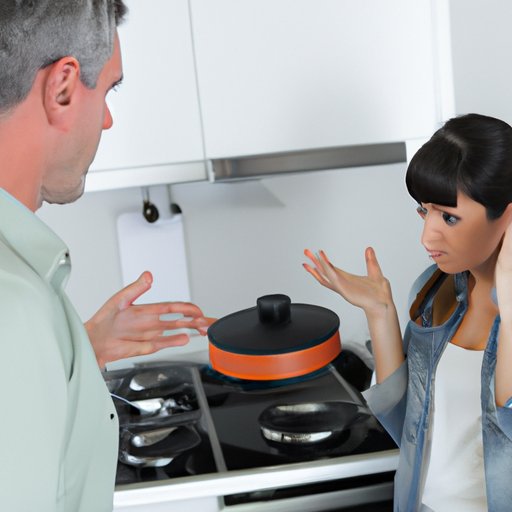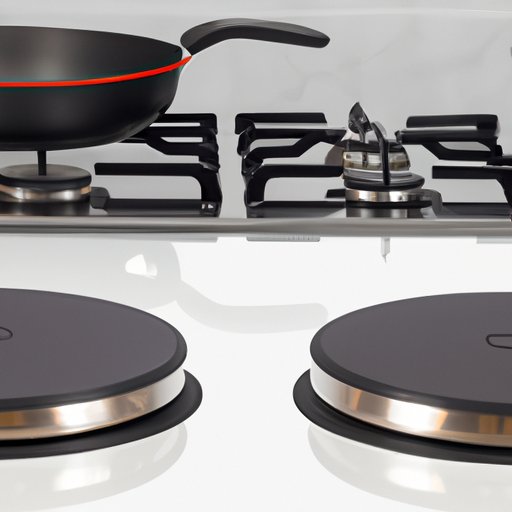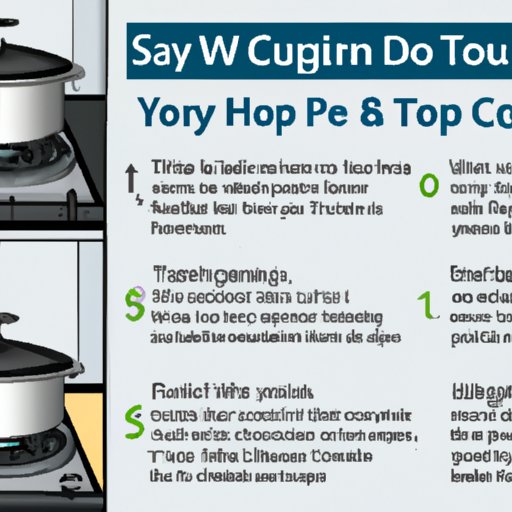Introduction
Induction stovetops are a revolutionary way to cook that uses electromagnetic energy to transfer heat directly to the cookware. This type of stovetop has become increasingly popular in recent years due to its energy efficiency, fast cooking times, and improved food quality. In this article, we’ll explore how an induction stovetop works, how to use it safely and efficiently, and the benefits of cooking with one.

Explaining the Science of Induction Stovetops
Induction stovetops work by using electromagnetism to create heat. The stovetop is equipped with an induction coil, which generates a powerful magnetic field when electricity passes through it. When a ferromagnetic material – such as stainless steel or cast iron – is placed on the induction coil, the magnetic field induces an electric current in the metal. This electric current creates resistance and friction, which generates heat. As the heat is generated directly in the cookware, the induction stovetop itself remains cool to the touch.
The advantages of induction cooking are numerous. It’s more efficient than traditional gas or electric stoves, as it only heats the cookware and not the surrounding air. This means that less energy is lost during the cooking process. Additionally, induction cooking is faster than other methods, as the heat is transferred directly to the cookware and there is no preheating time required. Lastly, because the heat is more evenly distributed, food cooked on an induction stovetop tends to have a better quality and taste.
A Step-by-Step Guide to Using an Induction Stovetop
Using an induction stovetop is relatively straightforward, but there are some important steps you should follow. Here’s a step-by-step guide to using your induction stovetop correctly:
1. Preparing the Cooktop. Before you begin cooking, make sure the cooktop is clean and free of debris. If necessary, wipe the surface with a damp cloth.
2. Setting the Temperature. Next, select the desired temperature setting. You can adjust the temperature in increments of 5-10 degrees, depending on the model.
3. Placing the Cookware. Place the cookware on the induction coil. Make sure the entire bottom of the pan is in contact with the coil, as this will ensure even heat distribution.
4. Adjusting the Heat. After the cookware is in place, adjust the heat setting if needed. You can also use the timer feature to set a specific cooking time.
Once you’re done cooking, turn off the stovetop and allow the cookware to cool before handling it.

Comparing Induction and Traditional Stovetops
When deciding between an induction stovetop and a traditional stovetop, there are several factors to consider. Here’s a comparison of the two types of cooktops:
Cost. Induction stovetops are typically more expensive upfront than traditional stovetops. However, they often cost less to operate over the long term due to their energy efficiency.
Efficiency. As mentioned earlier, induction stovetops are much more efficient than traditional stovetops. This means they waste less energy and produce less heat, making them a great choice for those looking to reduce their energy consumption.
Safety. Induction stovetops are generally safer than traditional stovetops, as they don’t produce open flames or hot surfaces. Additionally, since the heat is generated directly in the cookware, there is less risk of accidental burns.

Safety Tips for Using an Induction Stovetop
While induction stovetops are generally safe to use, there are still some safety precautions you should take when using one. Here are a few tips to keep in mind:
Avoid Overheating. As with any stovetop, it’s important to avoid overheating your cookware. Doing so can cause the cookware to warp or even catch fire.
Use Appropriate Cookware. Not all cookware is suitable for induction stovetops. Make sure to use cookware that is designed for induction cooking, such as stainless steel or cast iron.
Clean the Cooktop Regularly. To ensure optimal performance, make sure to clean the cooktop regularly. Wipe down the surface with a damp cloth after each use.
Design and Features of an Induction Stovetop
Induction stovetops come in a variety of designs, sizes, and features. Here are some of the most common features you’ll find on an induction stovetop:
Controls. Most induction stovetops have touch-sensitive controls for adjusting the heat settings and timers. Some models also offer additional features such as a child lock or power boost.
Power Settings. Most induction stovetops have multiple power settings, allowing you to choose the ideal level of heat for your recipe. High-end models may also offer adjustable wattage settings.
Timers. Many induction stovetops come with a built-in timer, which allows you to set a specific cooking time and then automatically shut off the stovetop when the timer expires.
Benefits of Cooking with an Induction Stovetop
Cooking with an induction stovetop offers numerous benefits. Here are some of the biggest advantages:
Energy Efficiency. As mentioned earlier, induction stovetops are much more efficient than traditional stovetops. This means less energy is wasted during the cooking process, resulting in lower utility bills.
Faster Cooking Times. Induction stovetops heat up quickly and maintain a consistent temperature throughout the cooking process, resulting in faster cooking times. This makes it perfect for busy households who don’t have a lot of time to spare.
Improved Food Quality. Since the heat is distributed more evenly, food cooked on an induction stovetop tends to have a better texture and flavor. Additionally, the lack of open flames makes it easier to control the heat and prevent burning.
Troubleshooting Common Problems with Induction Stovetops
Even the best induction stovetops can experience occasional problems. Here are some of the most common issues and how to fix them:
Poor Cooking Performance. If the food is not cooking properly, check to make sure the cookware is compatible with the induction stovetop. If it is, try adjusting the temperature settings or power levels.
Incorrect Temperatures. If the food is cooking at the wrong temperature, check the temperature settings and make sure they are accurate. If not, adjust the settings accordingly.
Error Messages or Codes. If the stovetop displays an error code or message, it may be due to a malfunction. Try resetting the stovetop and see if the problem persists. If so, contact the manufacturer for assistance.
Conclusion
Induction stovetops are a revolutionary way to cook that offers numerous advantages over traditional stovetops. They are more energy efficient, faster, and safer, making them an excellent choice for busy households. With the help of this guide, you should now have a better understanding of how an induction stovetop works and how to use it safely and efficiently.
(Note: Is this article not meeting your expectations? Do you have knowledge or insights to share? Unlock new opportunities and expand your reach by joining our authors team. Click Registration to join us and share your expertise with our readers.)
